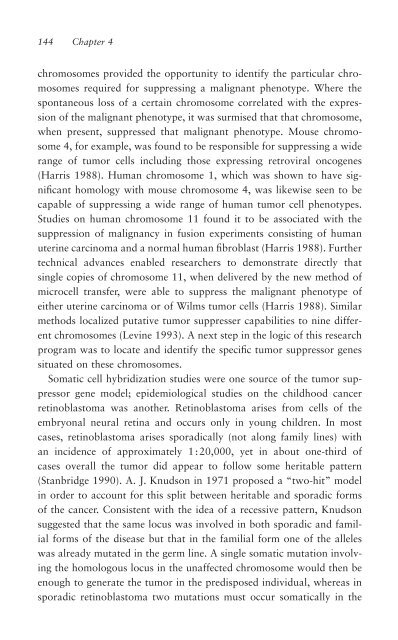A Critique of Pure (Genetic) Information
A Critique of Pure (Genetic) Information
A Critique of Pure (Genetic) Information
You also want an ePaper? Increase the reach of your titles
YUMPU automatically turns print PDFs into web optimized ePapers that Google loves.
144 Chapter 4<br />
chromosomes provided the opportunity to identify the particular chromosomes<br />
required for suppressing a malignant phenotype. Where the<br />
spontaneous loss <strong>of</strong> a certain chromosome correlated with the expression<br />
<strong>of</strong> the malignant phenotype, it was surmised that that chromosome,<br />
when present, suppressed that malignant phenotype. Mouse chromosome<br />
4, for example, was found to be responsible for suppressing a wide<br />
range <strong>of</strong> tumor cells including those expressing retroviral oncogenes<br />
(Harris 1988). Human chromosome 1, which was shown to have significant<br />
homology with mouse chromosome 4, was likewise seen to be<br />
capable <strong>of</strong> suppressing a wide range <strong>of</strong> human tumor cell phenotypes.<br />
Studies on human chromosome 11 found it to be associated with the<br />
suppression <strong>of</strong> malignancy in fusion experiments consisting <strong>of</strong> human<br />
uterine carcinoma and a normal human fibroblast (Harris 1988). Further<br />
technical advances enabled researchers to demonstrate directly that<br />
single copies <strong>of</strong> chromosome 11, when delivered by the new method <strong>of</strong><br />
microcell transfer, were able to suppress the malignant phenotype <strong>of</strong><br />
either uterine carcinoma or <strong>of</strong> Wilms tumor cells (Harris 1988). Similar<br />
methods localized putative tumor suppresser capabilities to nine different<br />
chromosomes (Levine 1993). A next step in the logic <strong>of</strong> this research<br />
program was to locate and identify the specific tumor suppressor genes<br />
situated on these chromosomes.<br />
Somatic cell hybridization studies were one source <strong>of</strong> the tumor suppressor<br />
gene model; epidemiological studies on the childhood cancer<br />
retinoblastoma was another. Retinoblastoma arises from cells <strong>of</strong> the<br />
embryonal neural retina and occurs only in young children. In most<br />
cases, retinoblastoma arises sporadically (not along family lines) with<br />
an incidence <strong>of</strong> approximately 1:20,000, yet in about one-third <strong>of</strong><br />
cases overall the tumor did appear to follow some heritable pattern<br />
(Stanbridge 1990). A. J. Knudson in 1971 proposed a “two-hit” model<br />
in order to account for this split between heritable and sporadic forms<br />
<strong>of</strong> the cancer. Consistent with the idea <strong>of</strong> a recessive pattern, Knudson<br />
suggested that the same locus was involved in both sporadic and familial<br />
forms <strong>of</strong> the disease but that in the familial form one <strong>of</strong> the alleles<br />
was already mutated in the germ line. A single somatic mutation involving<br />
the homologous locus in the unaffected chromosome would then be<br />
enough to generate the tumor in the predisposed individual, whereas in<br />
sporadic retinoblastoma two mutations must occur somatically in the
















